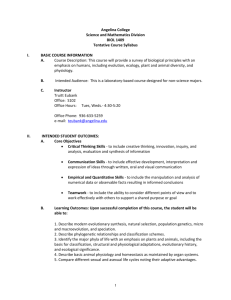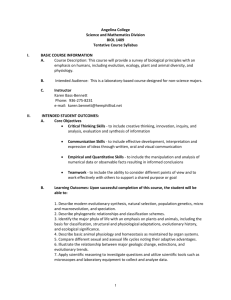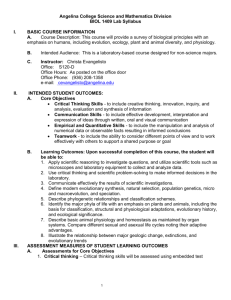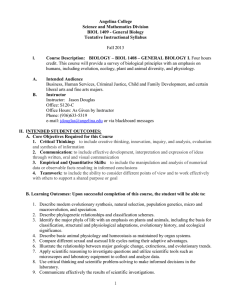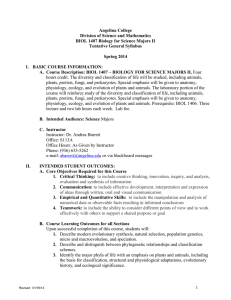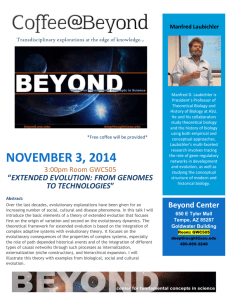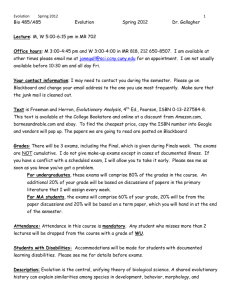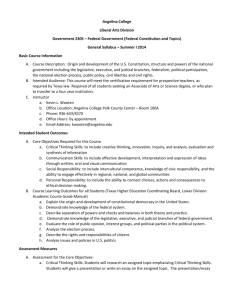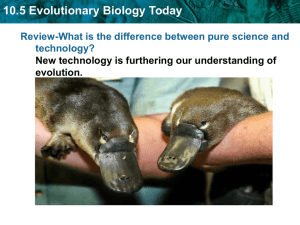Syllabus - Angelina College
advertisement
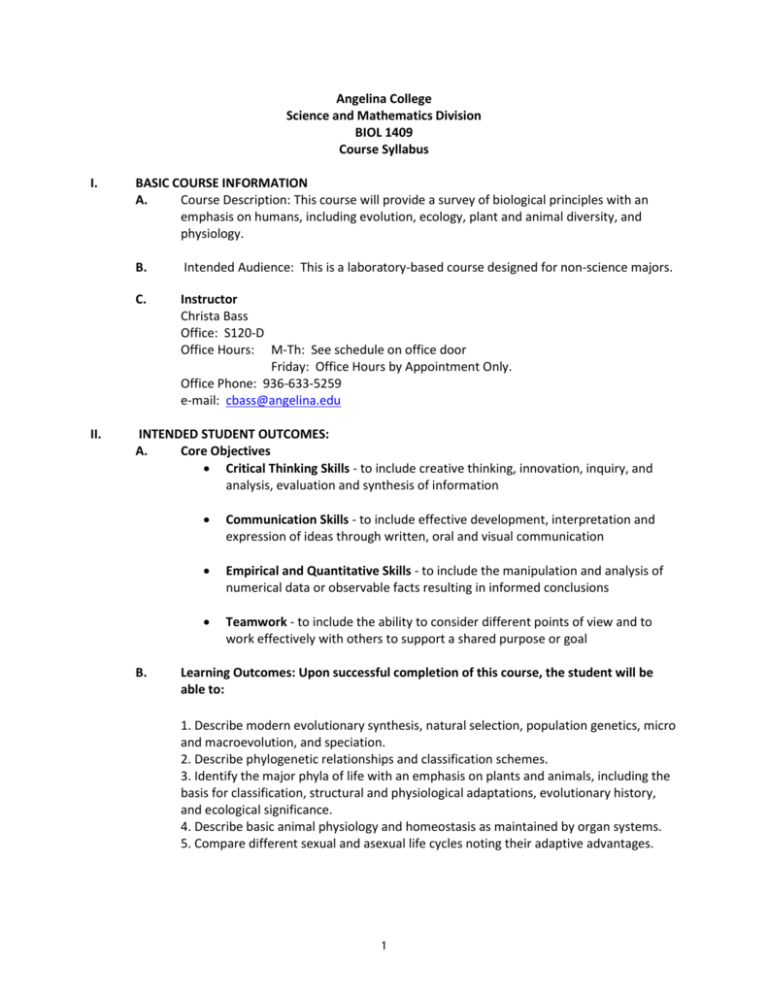
Angelina College Science and Mathematics Division BIOL 1409 Course Syllabus I. II. BASIC COURSE INFORMATION A. Course Description: This course will provide a survey of biological principles with an emphasis on humans, including evolution, ecology, plant and animal diversity, and physiology. B. Intended Audience: This is a laboratory-based course designed for non-science majors. C. Instructor Christa Bass Office: S120-D Office Hours: M-Th: See schedule on office door Friday: Office Hours by Appointment Only. Office Phone: 936-633-5259 e-mail: cbass@angelina.edu INTENDED STUDENT OUTCOMES: A. Core Objectives Critical Thinking Skills - to include creative thinking, innovation, inquiry, and analysis, evaluation and synthesis of information B. Communication Skills - to include effective development, interpretation and expression of ideas through written, oral and visual communication Empirical and Quantitative Skills - to include the manipulation and analysis of numerical data or observable facts resulting in informed conclusions Teamwork - to include the ability to consider different points of view and to work effectively with others to support a shared purpose or goal Learning Outcomes: Upon successful completion of this course, the student will be able to: 1. Describe modern evolutionary synthesis, natural selection, population genetics, micro and macroevolution, and speciation. 2. Describe phylogenetic relationships and classification schemes. 3. Identify the major phyla of life with an emphasis on plants and animals, including the basis for classification, structural and physiological adaptations, evolutionary history, and ecological significance. 4. Describe basic animal physiology and homeostasis as maintained by organ systems. 5. Compare different sexual and asexual life cycles noting their adaptive advantages. 1 6. Illustrate the relationship between major geologic change, extinctions, and evolutionary trends. 7. Apply scientific reasoning to investigate questions and utilize scientific tools such as microscopes and laboratory equipment to collect and analyze data. 8. Use critical thinking and scientific problem-solving to make informed decisions in the laboratory. 9. Communicate effectively the results of scientific investigations. III. ASSESSMENT MEASURES OF STUDENT LEARNING OUTCOMES A. Assessments for Core Objectives 1. Critical thinking – Critical thinking skills will be assessed using embedded test questions focusing on analysis, synthesis and evaluation of biological phenomena. 2. Communication – Communication skills will be assessed using lab reports and embedded test questions focusing on best practices in written, visual, and oral communication. 3. Empirical and Quantitative Skills – Empirical and quantitative skills will be introduced and assessed using embedded test questions focusing on calculations in genetics and population dynamics. 4. Teamwork – Teamwork skills will be assessed using teamwork skills in lab exercises as well as embedded test questions focusing on best practices. B. Learning Outcomes 1. Students will describe modern evolutionary synthesis, natural selection, population genetics, micro and macroevolution, and speciation with emphasis on evidence from extant taxa by answering multiple choice questions. 2. Students will distinguish between phylogenetic relationships and classification schemes and will develop and use cladograms. 3. Students will identify the major phyla of life with an emphasis on plants and animals, including the basis for classification, structural and physiological adaptations, evolutionary history, and ecological significance by answering multiple choice questions. 4. Students will describe basic animal physiology and homeostasis as maintained by organ systems. Students will be able to relate the function of organs and organ systems to maintaining homeostasis. These will be assessed with multiple choice questions. 5. Students will compare different sexual and asexual life cycles noting their adaptive advantages. Students will compare and contrast reproduction and life cycles of the major groups of plants, animals, and fungi by answering multiple choice questions. 6. Students will illustrate the relationship between major geologic change, extinctions, and evolutionary trends and will be able to relate the development of key derived features in extant taxa to similar features in extinct organisms by answering multiple choice questions. 7. Students will apply scientific reasoning to investigate questions in the laboratory and in analysis of real-world issues. Students will utilize scientific tools such as microscopes and laboratory equipment to collect and analyze data while performing lab experiments and exercises. 2 8. Students will use critical thinking and scientific problem-solving to make informed decisions in the laboratory as evidenced by developing appropriate, responsible research plans. These will be assessed with lab exams and reports. 9. Students will communicate effectively the results of scientific investigations in written reports, which will be assessed using a rubric. All Learning outcomes will be assessed through exams, quizzes, homework assignments & laboratory exercises. IV. INSTRUCTIONAL PROCEDURES A. Methodologies common to all sections This course will be taught using a combination of lectures and laboratory exercises that complement and supplement lecture material. Audio-visual materials, models, and dissection of specimens will be employed to enhance lecture and laboratory presentations. Online sections will do lecture lessons online, and labs at home with a lab kit. V. COURSE REQUIREMENTS AND POLICIES A. Required Textbooks and Equipment 1. Textbooks a. Campbell Biology Concepts and Connections by Reece, et al, (Pearson) Eighth Edition. B. b. Mastering Biology online textbook companion, (Pearson), (Code should come with book) c. Introductory Biology: A Laboratory Exploration of Life by Pfluger and Hall, (Kendall Hunt) 2nd Edition. Course Policies – (This course conforms to the policies of Angelina College as stated in the Angelina College Handbook.) Academic Assistance – If you have a disability (as cited in Section 504 of the Rehabilitation Act of 1973 or Title II of the Americans with Disabilities Act of 1990) that may affect your participation in this class, you should see Karen Bowser, Room 208 of the Student Center. At a post –secondary institution, you must self-indentify as a person with a disability; Ms. Bowser will assist you in with the necessary information to do so. Attendance Policy – Attendance will be required as per Angelina College Policy. Records will be turned in to the academic dean at the end of the semester. Do not assume that non-attendance in class will always in an instructor drop. You must officially drop a class or risk receiving a failing grade. This is official Angelina College Policy. The last day to drop the class with a “W” is Nov 10th. Policies Established by the Instructor Online course will have attendance monitored via activity in the course. For face to face courses attendance in both the lecture and laboratory portions of this course is absolutely required and will be taken at the beginning of each class period. A student’s 3 grade will be dropped ONE FULL LETTER GRADE if (1) a student has 3 or more absences in lecture or (2) a student has 3 or more absences in lab. Note: If a student has met both requirements (3 absences in both lecture & lab), their grade will drop 2 full letter grades from their final class average. Additional grade decreases will result if a student has 4 or more absences in either the lecture or laboratory portions of the class. Arriving and departing class on time is essential to the effective flow of classroom dynamics. As a result, late arriving and early exiting of the classroom will result in onehalf of an absence (i.e. two late arrivals = 1 full absence), unless otherwise pre-approved by the instructor. Course Conduct 1. Absolutely no cell phone use is allowed during labs or class. 2. No Food, drinks, or tobacco in class. 3. Courteous and respectful behavior will be expected in class at all times. VI. COURSE OUTLINE MW Aug 27 Sept 3 8 10 15 17 22 24 29 Oct 1 6 8 13 15 20 22 27 29 Nov 3 5 10 12 17 19 TR 28 2 4 9 11 16 18 23 25 30 2 7 9 14 16 21 23 28 30 4 6 11 13 18 Topic & Graded Assignments Course Introduction & Introduction to Biology Introduction to Evolution Evolutionary Principles Macroevolution Invertebrate Diversity Vertebrate Diversity Exam 1 (Chapters 1, 13-15 & 18-19) Animal Form & Function Digestion & Nutrition Gas Exchange Circulation Immune System Temperature & Water Balance Exam 2 (Chapters 20-25) Nervous System Sensory Systems Animal Locomotion Endocrine System Animal Reproduction Exam 3 (Chapters 26-30) Fungi and Fungal Diversity Plant Biology & Diversity Plant Biology & Diversity Plant Biology & Diversity 4 Chapter 1 13 14 15 18 19 20 21 22 23 24 25 28 29 30 26 27 17 31 32 33 Dec 24 1 3 8 10 20 2 4 9 11 Earth’s Environments (Video: Planet Earth) Exam 4 (Chapters 17 & 31-33) Population Ecology Community & Ecosystem Ecology Earth’s Environments (Video: Planet Earth) ***FINAL EXAM (Mon, Dec 15 11:00, Tue Dec 16 11:00)*** (Cumulative + Chapters 34, 36 & 37) 36 37 34 *Note: Students are HIGHLY encouraged to read the chapters prior to the corresponding lecture. This will stimulate educated questions and insights into the material, and will better prepare students for upcoming exams! VII. EVALUATION AND GRADING Test Format: Throughout the semester, 5 exams will be given to assess the students’ comprehension and understanding of the covered course material. These will consist of multiple choice and true/false questions. A comprehensive final will be given at the end of the semester, consisting of 50 questions over material covered in the first test, and 50 questions over recent material. Testing Procedures: If you are in an online course, SEE THE TESTING PROCEDURES OUTLINED BY THE INSTRUCTOR. For face to face courses: At the college level, academic honesty is of most importance. As a result, ALL PERSONAL BELONGINGS (including cell phones, backpacks, hats, etc…) will be placed at the front of the classroom before each test. A student may only take writing utensils, scantrons, a copy of the test, and a calculator (if necessary) to their desks on test days. * STUDENTS ARE REQUIRED TO PROVIDE THEIR OWN SCANTRONS (FORM 882-E) FOR EACH EXAM! Participation: Periodically there will be in-class activities in face to face courses that will be worth credit points. The point value will vary dependent on the activity. These points can only be earned by students completing the activity in class on the day it is assigned. Students who arrive late to lecture or are absent will not be given a make-up opportunity if they miss the activity for that day. Grading: Lecture grades will be determined by the total number of points earned from the possible points available. This includes exams and Mastering Biology online assignments. Lab grades will equal the proportion of the total number of points earned out of possible lab points. This will include lab reports as well as lab exams. Course grades will subsequently be determined using the following guidelines: Lecture = 2/3 of the total grade, & Lab = 1/3 of the total grade TOTAL PERCENTAGE FINAL GRADE 90+ % A 80 – 90% B 70 – 80% C 5 60 – 70% D SYLLABUS MODIFICATION B The instructor may modify the provisions of the syllabus to meet individual class needs by informing the class in advance as to the changes being made. 6
